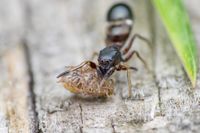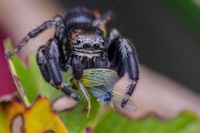Predation
Jumping spiders are extremely skilled hunters and are able to take down prey that is a lot larger than the spider itself. The preferences of the different species are very different. Even within the same species there are both brave and hesitant individuals. The most common are probably opportunistic hunters, who seize every opportunity that presents itself. The hunting tactics are very variable. Some species like "Phaecius sp." lurk for hours looking down and motionless on tree trunks for insects that come too close. Others actively roam their territory and sneak up on their prey like a big cat on a gazelle.
"Leptorchestes berolinensis" with bug; Kilchberg ZH, Switzerland
"Evarcha arcuata" with fruitfly; Kilchberg ZH, Switzerland
"Marpissa muscosa" with fly; Kilchberg ZH, Switzerland
"Salticus scenicus" with moth; Kilchberg ZH, Switzerland
Once the potential prey is within reach of the spider, it attaches a strand of silk to the surface and prepares to jump. As soon as the sensory hairs on the front legs report contact, they immediately attack and a poisonous bite is applied. Thorn-like hairs on the front legs secure the grip until the venom takes effect and immobilizes the prey, and the safety rope provides support as long as the prey struggles.
"Leptorchestes berolinensis" with maggot; Kilchberg ZH, Switzerland
"Hyllus diardi" with spider; Nakhon Pathom, Thailand
"Frigga sp." with ant; Cahuita, Costa Rica
"Evarcha arcuata" with leafhopper; Kilchberg ZH, Switzerland
Jumping spiders do not shy away from preying on other spiders, even jumping spiders of a different species or their own are not scorned. One would think that a hunter with such a keen sense of sight would evade another hunter's attack, but recognizing the surroundings takes a long time. With their tiny retinas, jumping spiders only see a very small area of their environment in high resolution and therefore have to scan their environment to get an overall picture.
"Marpissa muscosa" with "Leptorchestes berolinensis"; Kilchberg ZH, Switzerland
"Marpissa muscosa" with "Marpissa muscosa"; Kilchberg ZH, Switzerland
"Attulus terebratus" with "Attulus terebratus"; Kilchberg ZH, Switzerland
"Marpissa muscosa" with spiderling; Kilchberg ZH, Switzerland
I was able to observe a rare scene when a female (in the foreground) and a male "Marpissa muscosa" shared a fly. Unfortunately, I could not see which of the two had killed the prey. Was it a wedding present from the male, or was it simply an opportunity seized?
In the case of some orb-weaver spiders, it is known that the male offers the female a packed lunch in order to be able to mate unharmed. In the case of the list spider (Pisaura mirabilis), this is even an integral part of courtship, which earned it the name bridal gift spider.












